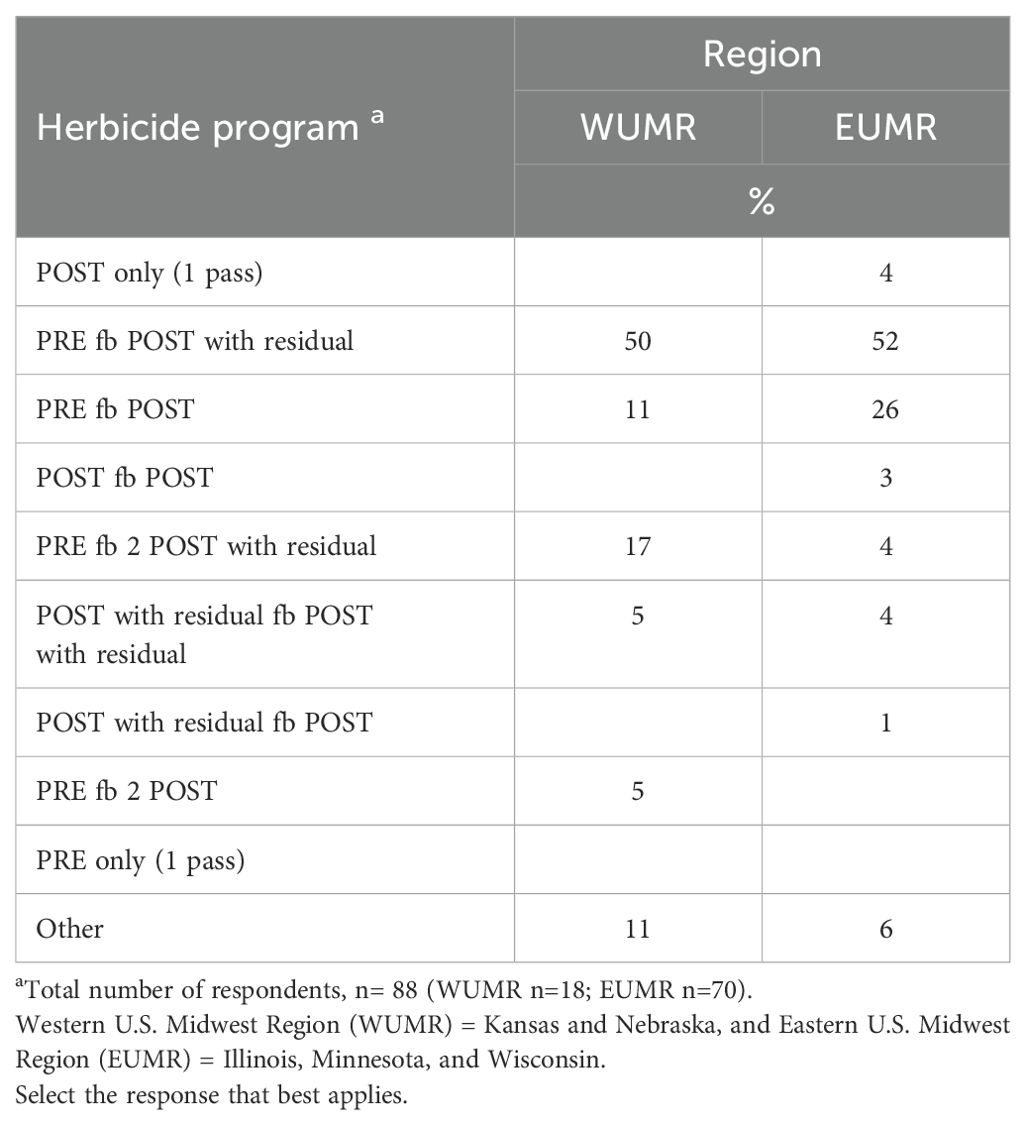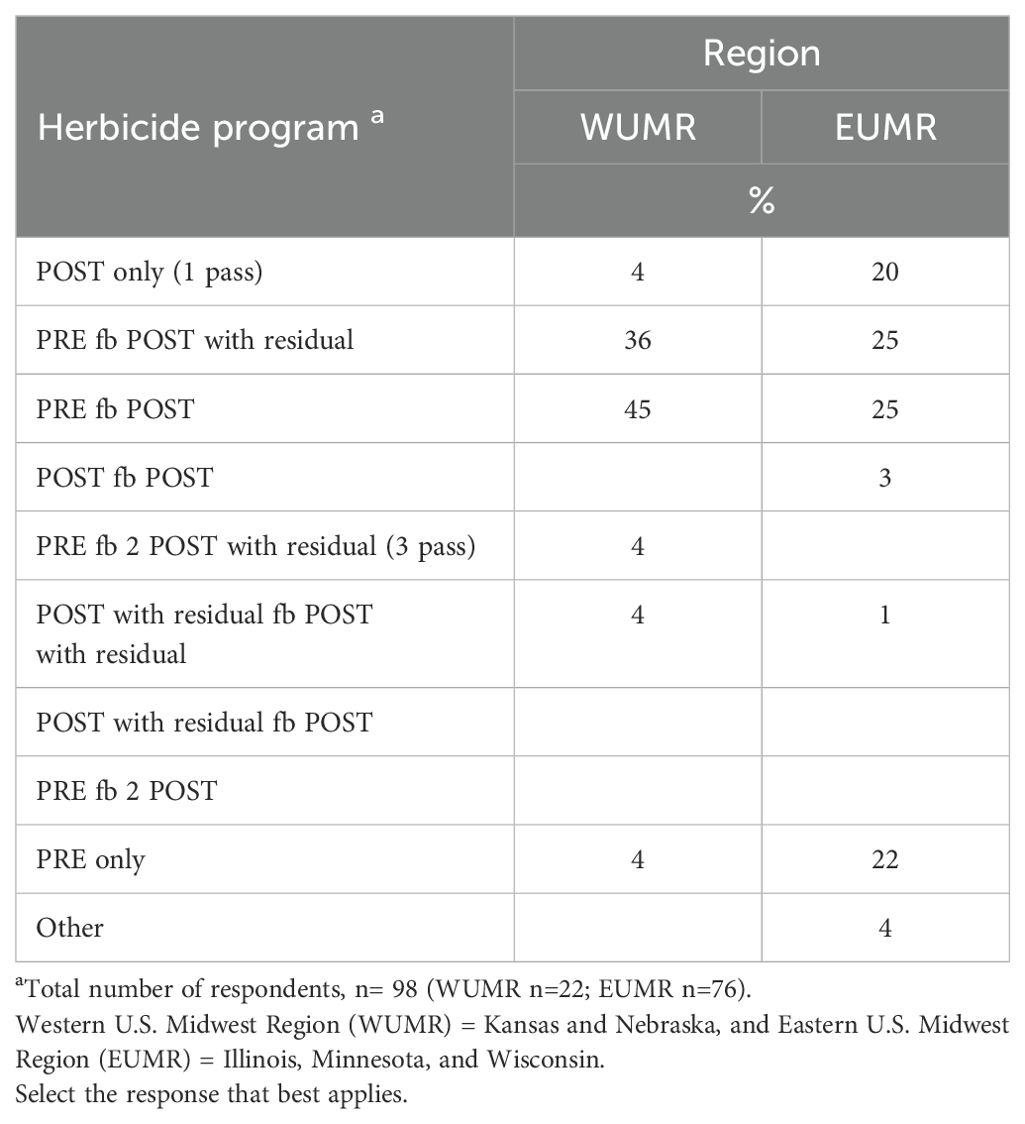- 1Department of Plant and Agroecosystems Sciences, University of Wisconsin-Madison, Madison, WI, United States
- 2Department of Agronomy and Horticulture, University of Nebraska-Lincoln, Lincoln, NE, United States
- 3Department of Agronomy, Kansas State University, Manhattan, KS, United States
Introduction: Understanding regional weed control practices and stakeholder perspectives is essential to guide the development and adoption of novel weed management technologies. This survey aimed to evaluate chemical weed control practices, major weed escapes, and stakeholder perceptions of targeted spraying technologies in corn and soybean cropping systems across the U.S. Midwest.
Methods: A survey was conducted from fall 2021 to spring 2022 in corn (Zea mays L.) and soybean [Glycine max (L.) Merr.] cropping systems across the Western U.S. Midwest Region (WUMR: Kansas and Nebraska) and the Eastern U.S. Midwest Region (EUMR: Illinois, Minnesota, and Wisconsin). It assessed currently adopted herbicide programs, end-of-season weed escapes, and awareness of targeted spraying technologies among growers, advisors, and applicators.
Results: Survey responses (128 participants) indicated that over 50% of growers used a two-pass herbicide application program [preemergence (PRE) followed by postemergence (POST) with layered residual] in soybean and corn across both regions in 2021. The top weed escapes in WUMR corn fields were Palmer amaranth (Amaranthus palmeri S.Wats.), waterhemp [Amaranthus tuberculatus (Moq.) J.D.Sauer], and foxtail species (Setaria spp.), while for soybean fields, Palmer amaranth, waterhemp, and volunteer corn were most common. Conversely, EUMR respondents primarily reported foxtail spp., waterhemp, and giant ragweed (Ambrosia trifida L.) escapes in corn and waterhemp, giant ragweed, and volunteer corn in soybean fields. Over 49% of respondents believe that novel targeted spraying technologies could help control late season weed escapes. However, more than 75% are unsure whether these technologies will be adopted in the operations they manage in the future, with 48% indicating the need of more information to support their decision. The survey results showed a greater reliance on commercial applicator services in the EUMR than WUMR, highlighting the potential role of commercial applicators in advancing effective herbicide strategies and targeted spraying technologies adoption while reducing the need for farmers to invest in new equipment within the EUMR region.
Discussion: This survey highlights substantial opportunities for targeted herbicide application technologies research and outreach education involving regulatory agencies, spray manufacturers, chemical companies, decision influencers, University Extension and other parties.
1 Introduction
The US Midwest region comprises approximately 51 million agricultural hectares, with 75% of arable area planted with corn and soybean (USDA - NASS, 2024). Weed interference can reduce corn and soybean yields by 50% and 52%, respectively, in U.S. and Canadian production systems, leading to annual losses exceeding 42 billion U.S. dollars (Soltani et al., 2016, 2017). Tillage and herbicide application are the primary practices for weed management in the US Midwest region (Dong et al., 2017). In 2020, over 95% of corn and soybean hectares in the US received at least one herbicide application (USDA - NASS, 2021). The significant use of herbicides in weed management for corn and soybean production highlights the benefits of chemical weed control for sustaining yield potential (Oerke and Dehne, 2004; Cooper et al., 2007; Damalas and Eleftherohorinos, 2011). Moreover, the use of herbicides provides economic benefits to growers by reducing the need for tillage and other labor and energy intensive weed control strategies (Gianessi, 2013). However, herbicide off-target movement (Soltani et al., 2020), environmental contamination (Maroni et al., 2006), and the growing issue of herbicide resistance (Heap, 2025) are significant challenges posed to chemical weed control.
Herbicide off-target movement can reduce pesticide efficacy and potentially cause injury to neighboring non-labeled crops, native species, and contaminate surrounding environments (De Snoo and van der Poll, 1999; Vieira et al., 2019; Bish et al., 2021). More precise and efficient herbicide applications are necessary to increase application accuracy and decrease off-target movement, environmental contamination, and public concerns regarding pesticide use in agriculture (Damalas and Eleftherohorinos, 2011; Sishodia et al., 2020). Brown et al. (2008) documented 40% reduction in spray application rate and 44% reduction in runoff with targeted applications when compared to traditional broadcast application methods. Therefore, precision agricultural technologies can have a critical role in reducing herbicide inputs and off-target movement (Myers et al., 2016; Camargo et al., 2020).
Site-specific precision agricultural tools such as unmanned aerial vehicle (UAV) systems and targeted spraying technologies can contribute to optimized agrochemical applications (Hunter et al., 2020). Unmanned aerial vehicles can be used for agrochemical applications when traditional sprayers cannot be employed (e.g., wet conditions) or in areas with limited access (e.g., forestry, around trees, electrical poles) (Qin et al., 2016; Anonymous, 2023a). Furthermore, UAVs are being increasingly used in precision agriculture to collect high-resolution remotely sensed data, aiding field management decisions and potentially reducing agrochemical impact on the environment (De Sa et al., 2018). For instance, De Sa et al. (2018) reported that early detection of weed infestations using aerial images enables the development of site-specific weed maps for ground sprayers, which can lead to significant herbicide savings. As advancements in precision agriculture continue, targeted spraying technologies are emerging as another innovative tool that leverages site-specific data to optimize agrochemical applications and further enhance their weed management efficiency.
Since the early 1990s, targeted spraying technology for ground sprayers is being developed, initially focusing on fallow applications (green-on-brown) with systems like Trimble WeedSeeker and WeedIt (Anonymous, 2021; Azghadi et al., 2024). In recent years, advancements in ground-based sprayer technology have enabled several manufacturers to develop targeted spraying technologies capable of real-time weed detection while differentiating weeds from established crops (green-on-green application) (McCarthy et al., 2010; Allmendinger et al., 2022). Ground-based targeted spraying technologies equipped with cameras can distinguish weeds from crops using artificial intelligence (AI)-driven algorithms and powerful computer units (multiple units mounted on the sprayer’s boom). These systems can process images within milliseconds, triggering the necessary nozzle(s) to deliver herbicides only where weeds are present, in contrast to traditional broadcast systems (Partel et al., 2019, 2020; Vijayakumar et al., 2023; Anonymous, 2024a). Delivering herbicides only where necessary can significantly reduce the amount of herbicide use and off-target movement in large scale agricultural commodity crops such as corn and soybean (Spaeth et al., 2024; Avent et al., 2024). Moreover, these targeted spraying technologies can generate high resolution geo-referenced weed infestation maps within the machine’s linked software (for example Xarvio’s Field Manager, John Deere’s See & Spray Field Analyzer, Greeneye’s Selective Spraying System) as soon as application is completed. Such maps can provide useful insight into weed infestation levels across the fields, helping end users make informed management decisions for future growing seasons. Since this is an emerging technology (green-on-green targeted spraying technology for ground sprayers), stakeholder awareness and adoption remain uncertain. Understanding the needs and challenges to adoption among stakeholders (agronomists, growers, crop consultants, and industry representatives) is essential for facilitating the integration of targeted spraying technologies in crops such as corn and soybean across the U.S. Midwest and beyond.
Surveys are essential for gathering information, supporting decision-making processes, and identifying current perceptions. By understanding the needs and challenges of regional agricultural communities, future educational and research initiatives can be better shaped. For example, a Missouri survey demonstrated the importance of pesticide applicators education regarding application of synthetic herbicides (Bish and Bradley, 2017). Currently, our understanding of the adoption rate and challenges associated with the incorporation of targeted spraying technologies in the U.S. Midwest, particularly in corn and soybean production, is limited. Stakeholder surveys can provide a broader perspective on the community’s perceptions regarding adoption of targeted spraying technology. Therefore, the objectives of this survey were (1) to assess current weed management practices, and identify which weeds are escaping current chemical weed control practices and 2) to understand stakeholders’ perceptions of new targeted spraying technologies and explore challenges and opportunities this technology may face in the future. These insights can support and structure research and extension efforts to better serve US Midwest corn and soybean producers with weed management strategies and anticipated challenges associated with adoption of emerging targeted spraying technologies.
2 Materials and methods
2.1 Survey’s structure
During the fall of 2021 and spring of 2022, an 18-question survey (Table 1) was designed to (1) document the main chemical weed control strategies utilized and the main end-of-season weed escapes (left uncontrolled due to herbicide-resistance or late emergence) detected in corn and soybean cropping systems across Kansas and Nebraska (WUMR) compared to Illinois, Minnesota, and Wisconsin (EUMR) in the 2021 growing season and to (2) understand stakeholders’ perceptions of new targeted spraying technologies and explore challenges and opportunities of their adoption. A digital (QualtricsXM; Provo, UT) survey was circulated via the social media platform X (former Twitter) (San Francisco, CA), email listservs, extension websites (e.g., K-State eUpdate, UNL-CropWatch, UW-Madison WiscWeeds.info), and promoted during Extension meetings in Kansas, Nebraska, and Wisconsin. The survey was organized into four sections. The first section (questions 1-4) focused respondent demographics (Table 1). The second (questions 5-9) and third (questions 10-15) sections focused on soybean and corn cropping system practices, respectively. The last section (questions 16-18) was focused on the adoption of and perceptions regarding targeted spraying technologies. The survey questions were designed as fill-in-the-blank, yes/no, and multiple choice. Not all participants answered every survey question (Oliveira et al., 2021).

Table 1. Survey of Corn-Soybean Weed Management During the 2021–2022 Growing Season and Current Stakeholder Perception on Targeted Spraying Technologies.
2.2 Data analysis
All results were exported from Qualtrics into a Microsoft Excel (Microsoft Office, Redmond, WA) spreadsheet, with responses to each question organized in separate columns. Survey data were sorted and analyzed in Microsoft Excel using the “count,” “filter,” and “sort” functions (Werle et al., 2018). Data visualization was performed using the tidyverse (Wickham et al., 2019) and ggplot2 (Wickham, 2016) packages in the R statistical software (R Development Core Team, 2024). For most questions, results were presented as the percentage of respondents selecting each answer choice (Werle et al., 2018). The respondents’ familiarity with targeted spraying technologies (ground-based sprayers) and their perspectives on the likelihood of adopting these technologies on the hectares they farm or manage in the future (binary response: Yes/No) were reported.
3 Results and discussion
3.1 Response rate and stakeholder composition
A total of 128 respondents participated in the survey (Figure 1). Of these, 26% (n=33) were from the WUMR and 74% (n=95) were from the EUMR. In the WUMR, 33% of respondents identified as farmers, 21% as agronomists, and 21% as crop consultants, while in the EUMR, 24% of respondents identified as farmers, 30% as agronomists, and 29% as crop consultants. Industry representatives accounted for 16% of respondents in the WUMR and 11% in the EUMR.
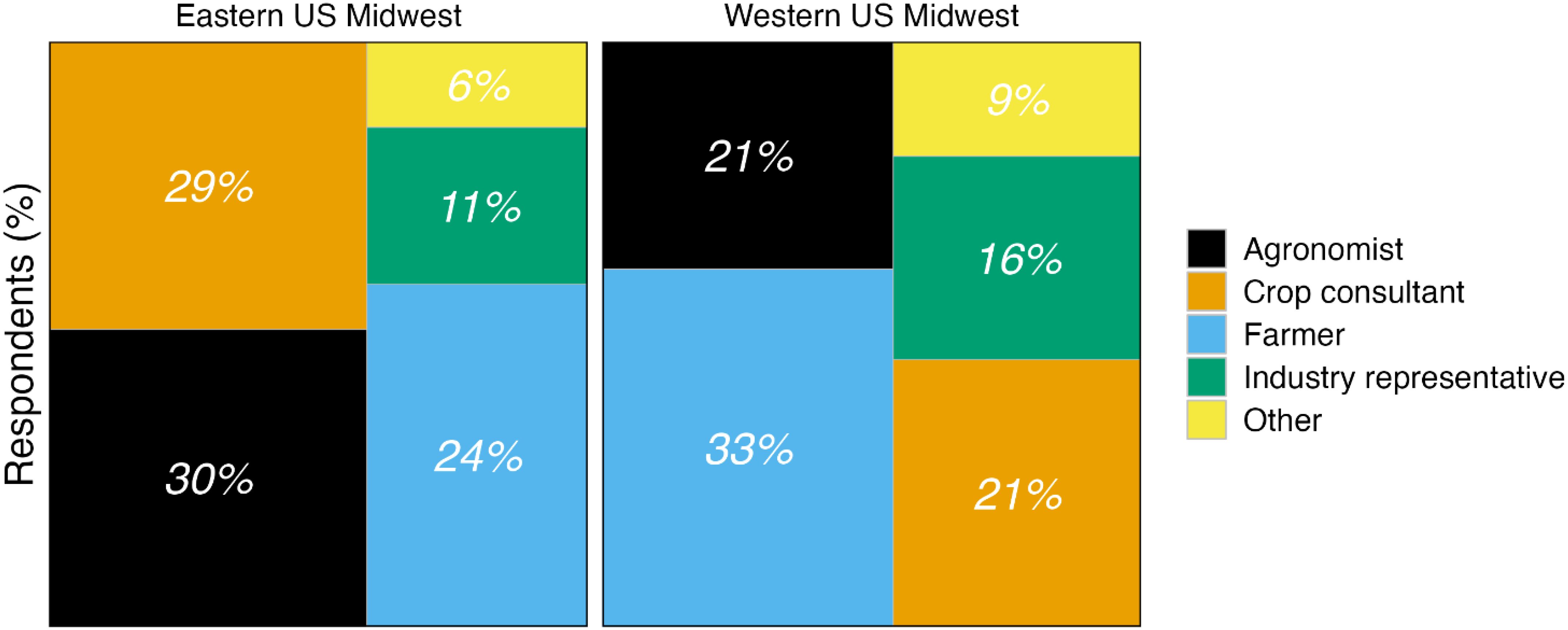
Figure 1. Q2-Describe your main occupation. Western U.S. Midwest Region (WUMR) = Kansas and Nebraska, and Eastern U.S. Midwest Region (EUMR) = Illinois, Minnesota, and Wisconsin.
3.2 Area farmed or managed
In 2021, survey respondents farmed or managed a total of 217,000 hectares of soybean and 318,000 hectares of corn (Question 4). Of the soybean hectares, WUMR accounted for 47,000 hectares, representing 1% of soybean hectares in Nebraska and Kansas, while EUMR covered 170,000 hectares, representing 2% of Soybean hectares in Illinois, Minnesota and Wisconsin (Anonymous, 2024a; USDA - NASS, 2024). For corn, WUMR accounted for 42,000 hectares, representing 1% of corn hectares in Nebraska and Kansas, while EUMR covered 276,000 hectares, representing 3% of corn hectares in Illinois, Minnesota and Wisconsin (Anonymous, 2024a; USDA - NASS, 2024).
3.3 Soybean herbicide strategies, operations and weed control satisfaction
According to survey respondents, 52% of soybean producers in the WUMR and 50% in the EUMR utilized the two-pass program (PRE followed by POST) with layered residuals in 2021 (Table 2). Additionally, 26% of soybean growers in the WUMR and 11% in the EUMR utilized the two-pass program without the layered residual approach. In both regions, only 4% of respondents utilized a one-pass program in soybean production systems. Therefore, two pass herbicide programs are common practice in both regions.
In WUMR, most soybean growers (54%) depend on commercial applicator services for 0 to 10% of their hectares, while 12% heavily depend on commercial application services for 91 to 100% of their managed hectares (Figure 2). In the EUMR, 32% of soybean growers rely on commercial applicator services for herbicide applications on 0 to10% of their managed hectares, while 21% depend on commercial applicator services for 91 to 100% of their managed hectares (Figure 2). Commercial applicator services play a crucial role in supporting farmers by investing in large scale equipment, providing expert advice and a variety of herbicide offerings, and integrating digital management tools (Anonymous, 2024b). The greater reliance on commercial applicator services in the EUMR highlights their important role in fostering the adoption of more cost-effective herbicide strategies and potentially impacting the implementation of targeted spraying technologies across a larger portion of farming operations, reducing the need for farmers to invest in new equipment.
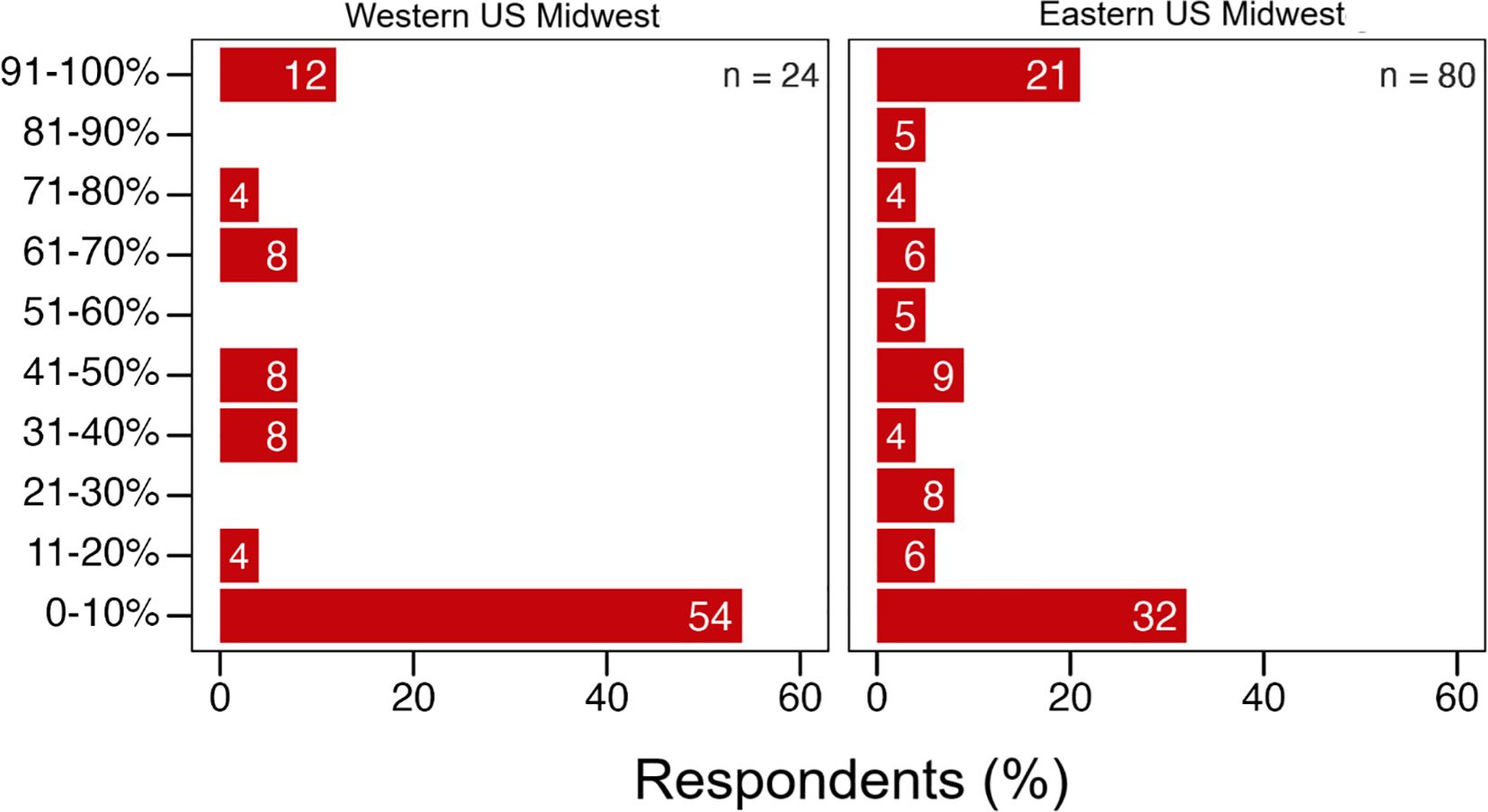
Figure 2. Q6-What percentage of the soybean acres you farm/manage were sprayed by a commercial applicator service (co-op) in 2021? Western U.S. Midwest Region (WUMR) = Kansas and Nebraska, and Eastern U.S. Midwest Region (EUMR) = Illinois, Minnesota, and Wisconsin.
In the WUMR, 32% of respondents reported being very satisfied (excellent weed control) with the performance of their weed control program (Figure 3). Furthermore, 48% indicated they were satisfied (good weed control), while 12% were somewhat satisfied (fair weed control). In the EUMR, 25% of respondents reported being very satisfied, 55% were satisfied, and 15% were somewhat satisfied with their weed control program. Most respondents in both regions reported utilizing the two-pass program in soybean, a practice aligned with research recommendations to achieve effective (>90%) season long control of herbicide-resistant weeds such as Palmer amaranth (Kumar et al., 2021), waterhemp (Duenk et al., 2023a), horseweed (Erigeron canadensis L.) (Duenk et al., 2023b), and giant ragweed (Striegel et al, 2021; Mobli et al., 2025). However, growers should prioritize adopting a diverse and integrated weed management program to ensure sustainability and prolong the effectiveness of available herbicide options.
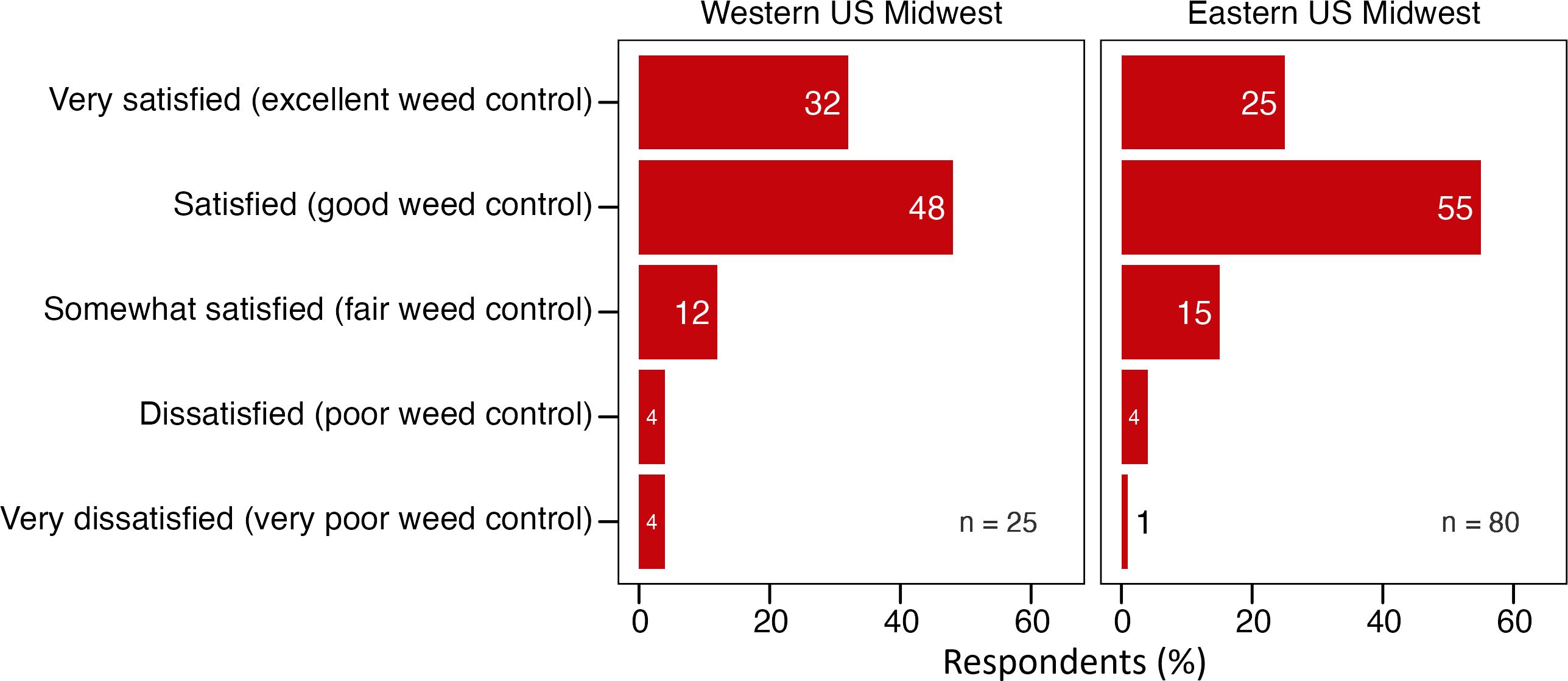
Figure 3. Q7- How satisfied were you with weed control in the soybean fields you farm/manage in 2021? Western U.S. Midwest Region (WUMR) = Kansas and Nebraska, and Eastern U.S. Midwest Region (EUMR) = Illinois, Minnesota, and Wisconsin.
3.4 Cost of herbicide application in soybeans
In 2021, soybean producers reported chemical weed control costs (including chemical and application cost) ranging from $55 to $100 per hectare in the WUMR and from $31 to $70 per hectare in the EUMR, depending on their herbicide program strategies (Figure 4). In the WUMR, a two-pass herbicide program with layered residual herbicides costed an average of $66 per hectare, compared to $55 per hectare for a two-pass program without residual herbicides. Similarly, in the EUMR, soybean producers spent an average of $45 per hectare for a two-pass herbicide program with layered residual herbicides, compared to $58 per hectare for a program without residual herbicides in 2021. The cost of chemical weed control in soybean production can vary widely depending on the selected herbicide program, application rate, application technology, and the demographic and density of the weed community (Meseldžija et al., 2020; Kumar et al., 2021; Vishwakarma et al., 2023; Avent et al., 2024). Moreover, the presence of herbicide-resistant weed species, combined with adverse environmental interactions that reduce herbicide efficacy (Yu and Powles, 2014; Landau et al., 2024), can further increase these costs. Developing effective herbicide strategies requires balancing economic feasibility with the goals of achieving effective weed control.
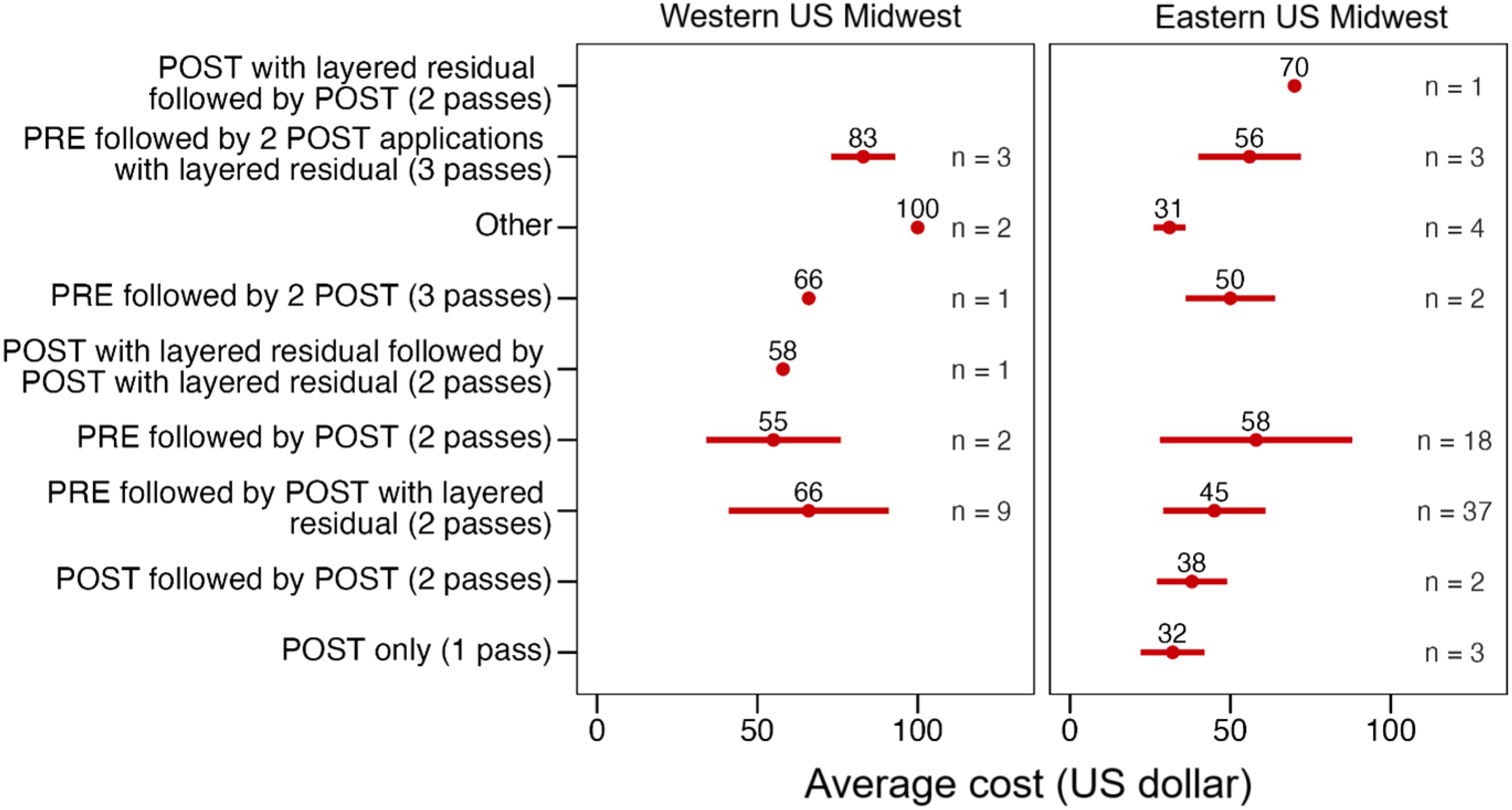
Figure 4. Q8 What was the average chemical weed control cost per hectare (including chemical and application cost) in the soybean fields you farm/manage in 2021? Western U.S. Midwest Region (WUMR) = Kansas and Nebraska, and Eastern U.S. Midwest Region (EUMR) = Illinois, Minnesota, and Wisconsin.
3.5 Weed escapes in soybean fields
In the WUMR, the most dominant weed species that escaped weed management practices in soybean fields were Palmer amaranth, waterhemp, volunteer corn, and velvetleaf (Abutilon theophrasti Medik) (Figure 5). In the EUMR, the dominant weed species that escaped herbicide control included waterhemp, giant ragweed, volunteer corn, velvetleaf, and horseweed. Palmer amaranth, waterhemp, giant ragweed, velvetleaf, and horseweed are consistently recognized as major threats to soybean production across the Midwest (WSSA, 2017; Arsenijevic et al., 2022; Chudzik et al., 2024) due to their rapid growth, high seed production, and resistance to multiple herbicide modes of action (Harrison et al., 2001; Shrestha et al., 2010; Arsenijevic et al., 2022; Heap, 2025). Likewise, volunteer corn, often underestimated as a weed in soybean fields (Chahal and Jhala, 2015; Alms et al., 2016), has been shown to cause yield losses of up to 40% at low densities with maximum yield loss reaching 71%, highlighting its competitiveness similar to many common Midwestern weed species (Alms et al., 2016).
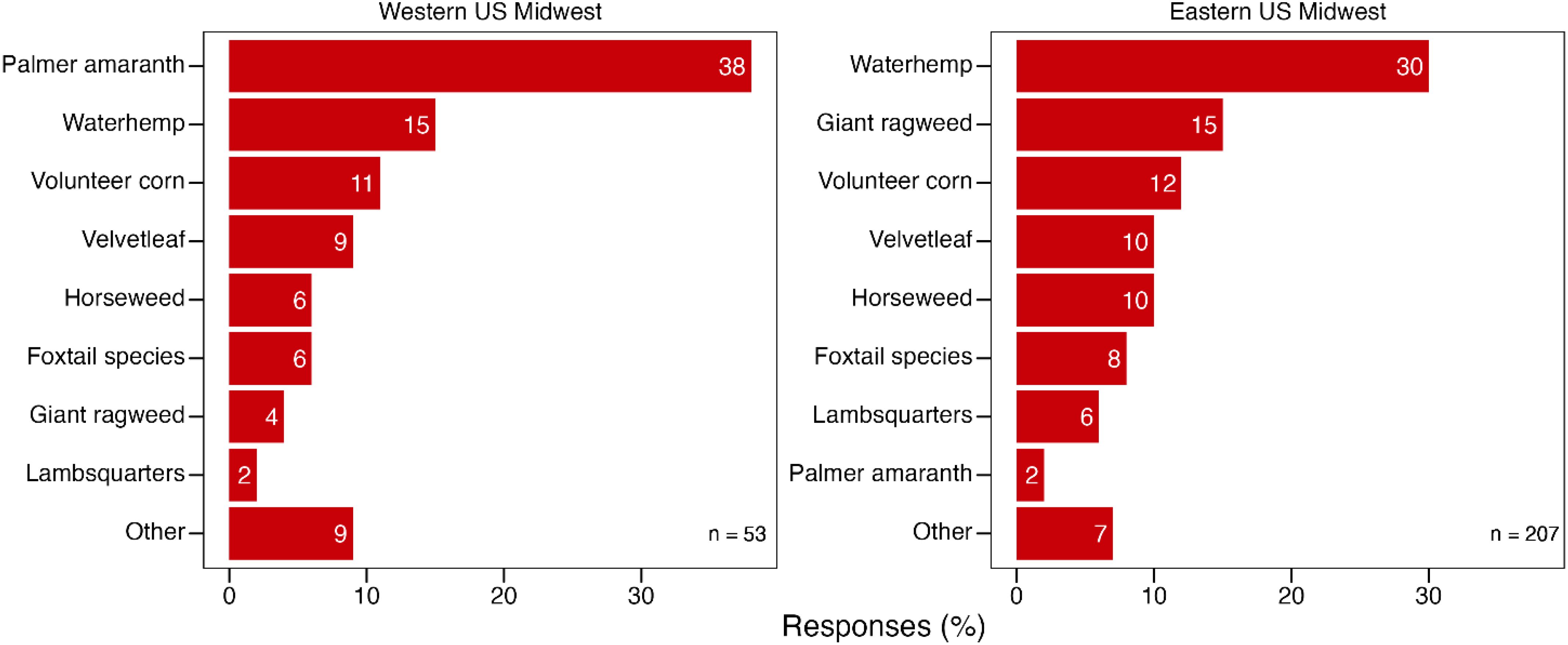
Figure 5. Q9-What weeds escaped control in the soybean fields you farm/manage in 2021? Western U.S. Midwest Region (WUMR) = Kansas and Nebraska, and Eastern U.S. Midwest Region (EUMR) = Illinois, Minnesota, and Wisconsin.
3.6 Corn herbicide strategies, operations and weed control satisfaction
In the WUMR, the PRE followed by (fb) POST without layered residual herbicides (45%) and the PRE fb POST with layered residual herbicides (36%) were the most dominant herbicide strategies in corn production systems (Table 3). In contrast, in the EUMR, commonly used herbicide strategies included POST-only (20%), PRE fb POST with layered residual herbicides (25%), PRE fb POST without layered residual herbicides (25%), and PRE-only (22%). Selecting effective herbicide strategies is critical for corn growers. While a single pass herbicide strategy is still common in the EUMR, recent research recommends two-pass herbicide strategies as the most effective and reliable option for achieving consistent, end-of-season weed control, regardless of weed species composition or environmental conditions (Mobli et al., 2023, 2025). However, a one-pass herbicide strategy may still be effective for managing specific weed communities with low densities in conventional tillage corn production (Mobli et al., 2025).
In the WUMR, most corn growers (64%) relied on commercial applicator services for 0 to 10% of their land, while 9% were highly dependent on commercial applicator services for 91 to 100% of their managed hectares (Figure 6). In contrast, in the EUMR, reliance on commercial applicator services varied among corn growers, with 36% dependent on commercial applicator services for 0 to 10% of their land and over 30% relied on commercial applicator services for herbicide applications on 50 to 100% of their hectares. This highlights the significant dependence of EUMR producers on commercial applicator services, underscoring the need for specialized support to address logistical challenges that impact profitability and increase operational costs.
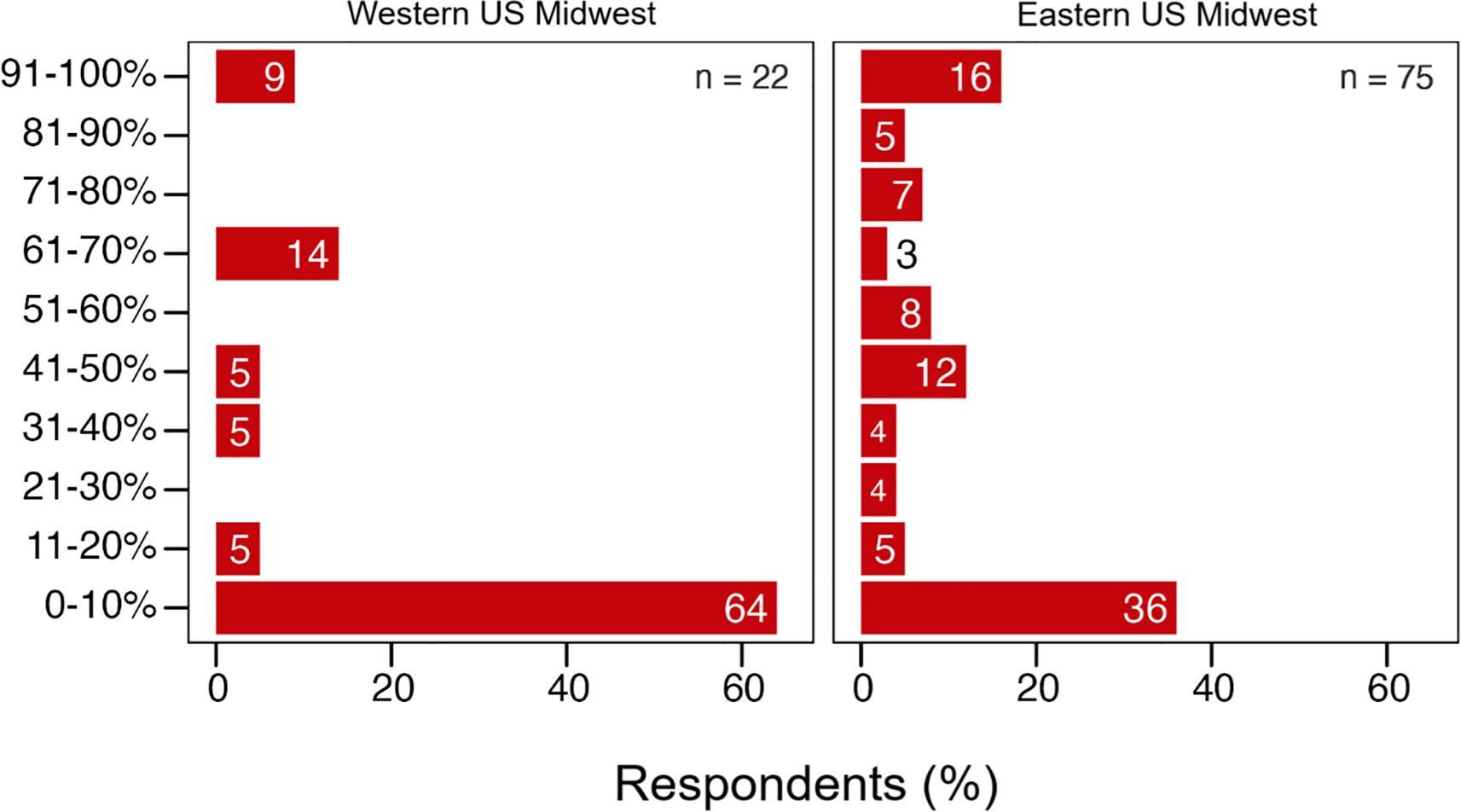
Figure 6. Q12-What percentage of the corn acres you farm/manage were sprayed by a commercial applicator service (co-op) in 2021? Western U.S. Midwest Region (WUMR) = Kansas and Nebraska, and Eastern U.S. Midwest Region (EUMR) = Illinois, Minnesota, and Wisconsin.
In the WUMR, 36% of respondents were very satisfied with their weed control program, while 45% were satisfied, and 18% reported they were somewhat satisfied (Figure 7). In the EUMR, 25% of respondents were very satisfied, 64% were satisfied, and 11% reported they were somewhat satisfied with their weed control program.
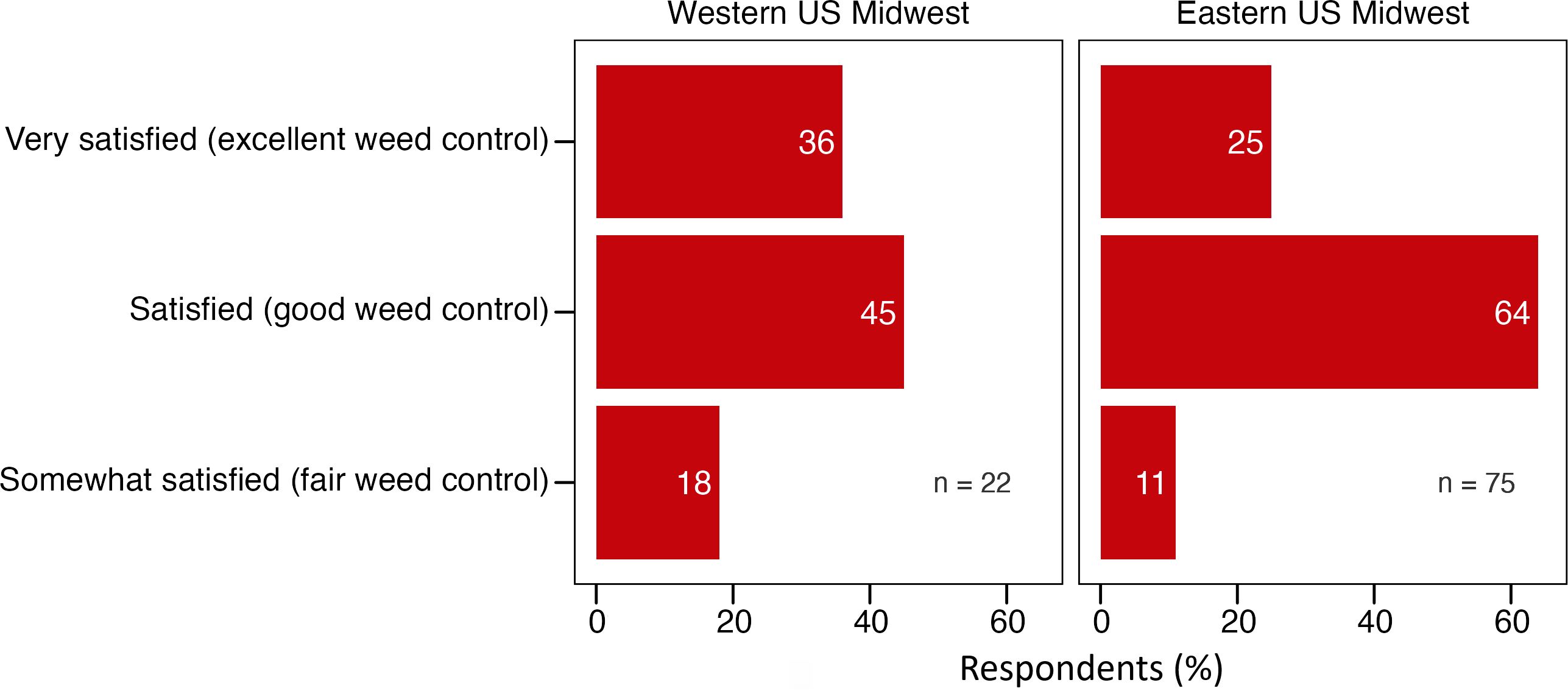
Figure 7. Q13-How satisfied were you with weed control in the corn fields you farm/manage in 2021? Western U.S. Midwest Region (WUMR) = Kansas and Nebraska, and Eastern U.S. Midwest Region (EUMR) = Illinois, Minnesota, and Wisconsin.
3.7 Cost of herbicide application in corn
In 2021, corn producers estimated chemical weed control costs (including chemical and application cost) ranging from $54 to $61 per hectare in the WUMR and from $20 to $70 per hectare in the EUMR, depending on their herbicide application strategies (Figure 8). In the WUMR, a PRE fb POST application with layered residuals costed an average of $61 per hectare, compared to $57 per hectare for a two-pass herbicide program without layered residuals on average. In the EUMR, the average cost of a PRE fb POST program with layered residuals was $43 per hectare, while a two-pass program without residuals costed an average of $45 per hectare. Additionally, in the EUMR, the average cost of a one-pass PRE was $32 per hectare, compared to $39 per hectare for a one-pass POST. Herbicides remain the most common tools for weed management in corn and soybean production systems in US Midwest (Dong et al., 2017) however higher herbicide costs and lower commodity prices can greatly affect growers’ production profitability margins (Anonymous, 2023b).
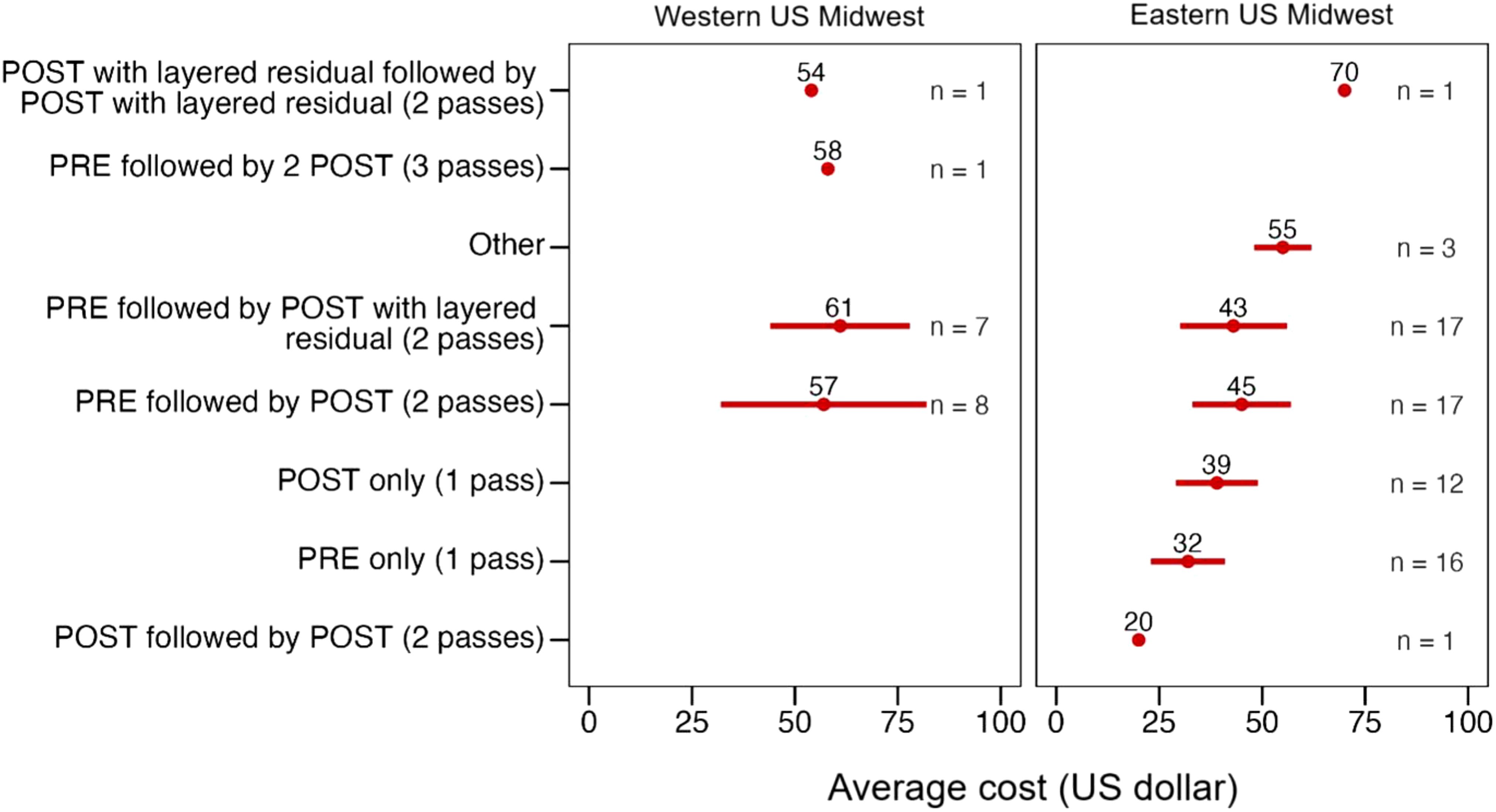
Figure 8. Q14-What was the average chemical weed control cost per hectare (including chemical and application cost) in the corn fields you farm/manage? Western U.S. Midwest Region (WUMR) = Kansas and Nebraska, and Eastern U.S. Midwest Region (EUMR) = Illinois, Minnesota, and Wisconsin.
3.8 Weed escapes in corn fields
The most common weed species that escaped herbicide control in the WUMR were Palmer amaranth, waterhemp, and foxtail species (Figure 9). In contrast, in the EUMR, the predominant weed species that escaped herbicide control were foxtail species, waterhemp, giant ragweed, and barnyardgrass. Weeds in corn can escape control due to factors such as herbicide resistance (Recker et al., 2015), poorly timed weed management practices, and adverse interactions between these practices and environmental conditions (Scursoni et al., 2007; Johnson et al., 2007; Krähmer, 2016). Even if escaped weed species were to have minimal impact on crop yields, their seed production poses a significant concern by replenishing the soil seedbank and intensifying future weed challenges (Bagavathiannan and Norsworthy, 2012). Moreover, identifying escaped weeds is critical for developing effective weed management programs, as it offers valuable insights into missed weed management opportunities by current strategies.
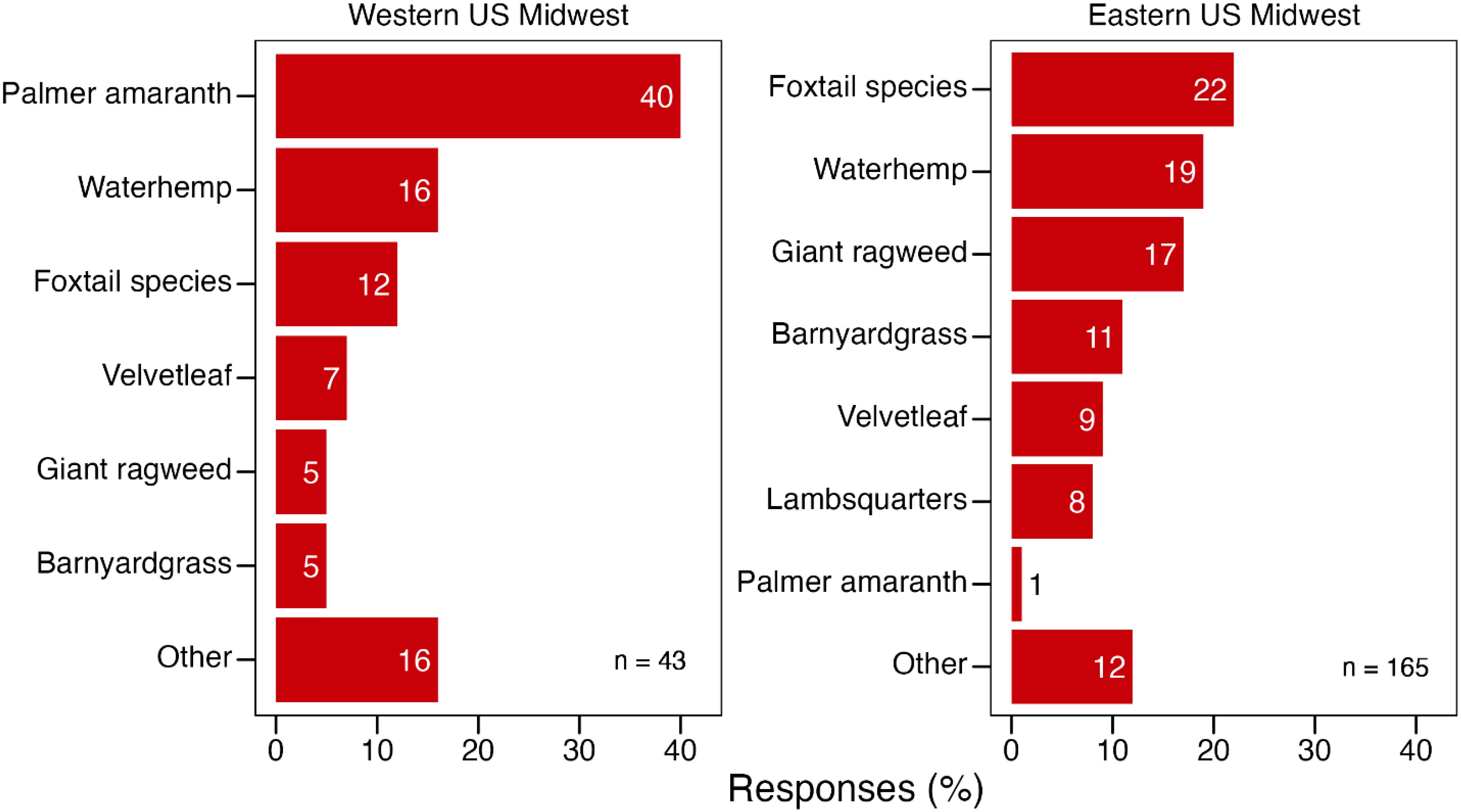
Figure 9. Q15- What weeds escaped control in the corn fields you farm/manage in 2021? Western U.S. Midwest Region (WUMR) = Kansas and Nebraska, and Eastern U.S. Midwest Region (EUMR) = Illinois, Minnesota, and Wisconsin.
3.9 Familiarity and perspective of growers on targeted spraying technologies
Most respondents in the WUMR (65%) and EUMR (68%) were familiar with targeted spraying technologies (Question 16). In the WUMR, 48% of respondents did not consider adoption of targeted spraying technologies a viable option and another 48% were unsure or indicated they needed more information about these technologies before considering their use (Figure 10), and only 2% of respondents in the WUMR anticipated adopting targeted spraying technologies for herbicide application in their future operations. In contrast, 17% of respondents in the EUMR anticipated adopting targeted spraying technologies for their herbicide application in future operations, though 31% of respondents did not consider targeted spraying technologies a viable option for adoption and another 53% were unsure or indicated they would need more information before considering their use.
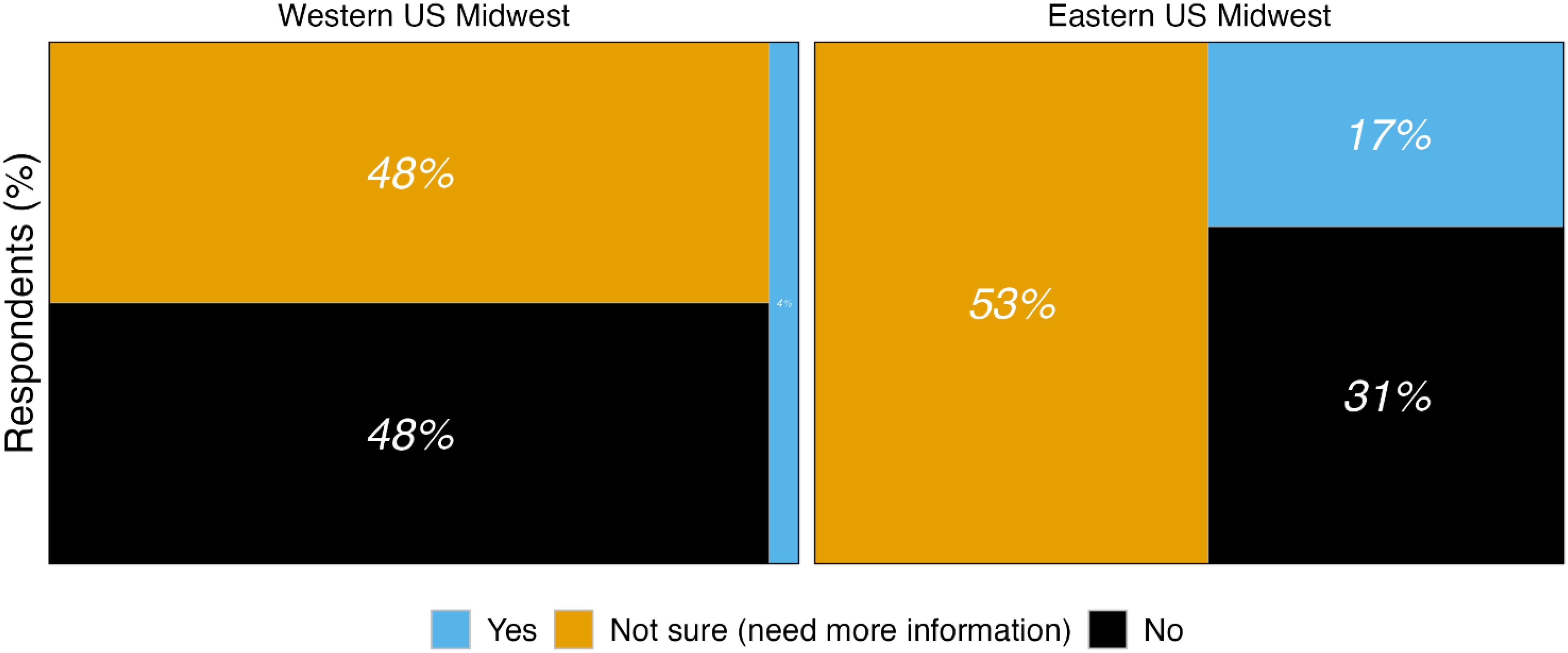
Figure 10. Q17- Do you foresee targeted spraying technologies being adopted in the hectares you farm/manage in the near future? Western U.S. Midwest Region (WUMR) = Kansas and Nebraska, and Eastern U.S. Midwest Region (EUMR) = Illinois, Minnesota, and Wisconsin.
Nine percent of respondents in the WUMR and 6% in the EUMR anticipated targeted spraying technologies being adopted as part of all herbicide applications (Figure 11). The majority of respondents from the WUMR (57%) and the EUMR (49%) anticipated targeted spraying technologies being utilized for controlling late season weed escapes. However, current targeted spraying technologies face challenges in detecting weeds later in the season due to the advanced growth stages of both crops and weeds (Adhinata and Sumiharto, 2024). Moreover, escaped weeds in advanced growth stages late season are typically less susceptible to herbicides (Blackshaw and Harker, 1996; Chauhan and Abugho, 2012). Therefore, the adoption of this technology for controlling late season weed escapes may not be the most effective approach for its use thus further research is warranted. The survey results highlighted a critical need to raise awareness about targeted spraying technologies and increase understanding of their effectiveness across various application timings, with the goal of supporting best management practices for adoption of this emerging technology.

Figure 11. Q18- How do you foresee targeted spraying technologies being adopted in corn and soybean production fields in the near future. Western U.S. Midwest Region (WUMR) = Kansas and Nebraska, and Eastern U.S. Midwest Region (EUMR) = Illinois, Minnesota, and Wisconsin.
Among respondents, 13% in the WUMR and 19% in the EUMR anticipated adopting targeted spraying technologies exclusively as part of POST herbicide applications (Figure 11). Targeted sprayers equipped with green-on-green technology hold significant potential as an alternative to traditional POST applications. However, previous studies have demonstrated that under high weed densities, targeted spraying technologies function similarly to traditional broadcast systems, diminishing the benefit of targeted applications (Ugljic et al., 2024). Moreover, in the presence of troublesome weed species such as giant ragweed, at a high density, a single POST application showed the lack of effective weed control (Mobli et al., 2025). A robust PRE herbicide program can reduce weed populations throughout the growing season (Trolove et al., 2011; Silva et al., 2023) and enhance the effectiveness of POST herbicide applications with targeted spraying technologies.
The current survey revealed that most respondents utilized a two-pass herbicide program; however, problematic and common weeds such as Palmer amaranth, waterhemp, giant ragweed, foxtail species, and volunteer corn were reported to escape control. Eighty and 81% of soybean and corn growers in both regions reported satisfaction with their current weed management practices. Satisfactorily season-long chemical control depends on multiple factors, including environmental conditions, herbicide options, application strategies, operational costs, and the composition of the weed community (Varanasi et al., 2016; Zhao et al., 2017). To be widely adopted, novel targeted application technologies will likely need to provide at least equal, if not better, end-of-season weed control and economic return compared to standard broadcast applications. The integration of targeted application technologies as part of POST programs provides a unique opportunity for growers and applicators to apply robust rates of labeled foliar herbicides and herbicide mixtures that would be deemed unacceptable from a crop response and/or economic standpoint, while potentially enhancing weed control, thus grower satisfaction. Moreover, the recent updates regarding Endangered Species Act (EPA, 2024) will impose stricter runoff mitigation and spray drift reduction requirements for herbicides being registered and reregistered. In this context, adopting targeted spraying technologies offers a potential solution to reduce foliar herbicide use, herbicide off-target movement, herbicide runoff, and potential input costs (Brown et al., 2008). In addition, integrating non-chemical weed management strategies into corn and soybean programs should not be overlooked, as most Midwest farmers rely heavily on chemical control.
This survey highlights the importance of understanding growers’ perspectives in implementing targeted spraying technologies as part of effective weed management strategies for corn and soybean production that can either maintain or improve weed control satisfaction and reduce the number of weed escapes. Research priorities identified through the survey highlight the need to raise awareness about the efficacy of targeted spraying technologies in detecting and controlling weeds, ideal application timings, overall herbicide use, and technology and application costs. A common comment provided by participants at the end of the survey was regarding best management practices for the use of soil residual herbicides as part of POST applications where target application technologies are used, which warrants future research. Insights from surveys like this are invaluable for guiding research efforts and advancing innovative weed management strategies and Extension outreach initiatives that benefit corn and soybean farmers across the Midwest and beyond.
Data availability statement
The raw data supporting the conclusions of this article will be made available by the authors, without undue reservation.
Author contributions
ZU: Writing – original draft, Resources, Data curation. AM: Writing – review & editing, Investigation. MO: Investigation, Formal analysis, Visualization, Writing – review & editing. CP: Supervision, Writing – review & editing, Data curation, Methodology, Conceptualization. JD: Data curation, Methodology, Conceptualization, Supervision, Writing – review & editing. RW: Conceptualization, Funding acquisition, Data curation, Project administration, Supervision, Writing – review & editing, Methodology.
Funding
The author(s) declare that financial support was received for the research and/or publication of this article. We thank the National Corn Growers Association (Grant No. MSN254842) and the North Central Soybean Research Program (Grant Nos. MSN266309 and MSN280182) for supporting this project. We also thank BASF Xarvio Digital Farming Solutions (Grant No. MSN258155) for partially sponsoring Zaim Ugljic's graduate research assistantship. BASF Xarvio Digital Farming Solutions was not involved in the study design, collection, analysis, interpretation of data, the writing of this article, or the decision to submit it for publication.
Acknowledgments
We thank all survey respondents for taking the time to share valuable insights into their weed management practices in their respective regions.
Conflict of interest
The authors declare that the research was conducted in the absence of any commercial or financial relationships that could be construed as a potential conflict of interest.
The reviewer SK declared a past co-authorship with the author(s) RW to the handling editor.
The author(s) declared that they were an editorial board member of Frontiers, at the time of submission. This had no impact on the peer review process and the final decision.
Generative AI statement
The author(s) declare that no Generative AI was used in the creation of this manuscript.
Correction note
This article has been corrected with minor changes. These changes do not impact the scientific content of the article.
Publisher’s note
All claims expressed in this article are solely those of the authors and do not necessarily represent those of their affiliated organizations, or those of the publisher, the editors and the reviewers. Any product that may be evaluated in this article, or claim that may be made by its manufacturer, is not guaranteed or endorsed by the publisher.
Abbreviations
barnyardgrass, Echinochloa crus-galli L. P. Beauv.; common cocklebur, Xanthium strumarium L.; common lambsquarters, Chenopodium album L.; common purslane, Portulaca oleracea L.; common ragweed, Ambrosia artemisiifolia L.; corn, Zea mays L.; fall panicum, Panicum dichotomiflorum Michx.; field bindweed, Convolvulus arvensis L.; giant foxtail, Setaria faberi Herrm.; giant ragweed, Ambrosia trifida L; horsenettle, Solanum carolinense L.; horseweed, Erigeron canadensis L.; johnsongrass, Sorghum halepense L. Pers; kochia, Bassia scoparia L.; large crabgrass, Digitaria sanguinalis L. Scop.; Palmer amaranth, Amaranthus palmeri S. Wats.; soybean, Glycine max L. Merr.; velvetleaf, Abutilon theophrasti Medik.; waterhemp, Amaranthus tuberculatus [Moq.] J.D. Sauer; yellow nutsedge, Cyperus esculentus L.
References
Adhinata F. D. and Sumiharto R. (2024). A comprehensive survey on weed and crop classification using machine learning and deep learning. Artif. Intell. Agric. 13, 45–53. doi: 10.1016/j.aiia.2024.06.005
Allmendinger A., Spaeth M., Saile M., Peteinatos G. G., and Gerhards R. (2022). Precision chemical weed management strategies: A review and a design of a new CNN-based modular spot sprayer. Agron 12, 1620. doi: 10.3390/agronomy12071620
Alms J., Moechnig M., Vos D., and Clay S. A. (2016). Yield loss and management of volunteer corn in soybean. Weed Technol. 30, 254–262. doi: 10.1614/WT-D-15-00096.1
Anonymous (2021). Sprayer 101. Available online at: https://sprayers101.com/optical-spraying-and-ai/ (Accessed May 2025).
Anonymous (2023a). Available online at: https://eupdate.agronomy.ksu.edu/article_new/unmanned-aerial-vehicle-pesticide-applications-what-you-need-to-know-550-3 (Accessed May 2025).
Anonymous (2023b). Available online at: https://farmdocdaily.illinois.edu/wp-content/uploads/2023/09/fdd092623.pdf (Accessed May 2025).
Anonymous (2024a). Our methods—welcome blue river technology. Available online at: https://bluerivertechnology.com/ourmethods/ (Accessed May 2025).
Anonymous (2024b). co-op driven to serve- corn protection. Available online at: https://www.ourcoop.com/agronomy/crop-protection (Accessed May 2025).
Arsenijevic N., DeWerff R., Conley S., Ruark M. D., and Werle R. (2022). Growth and development of multiple waterhemp (Amaranthus tuberculatus) cohorts in corn and soybeans. Front. Agron. 4, 1037483. doi: 10.3389/fagro.2022.1037483
Avent T. H., Norsworthy J. K., Patzoldt W. L., Schwartz-Lazaro L. M., Houston M. M., Butts T. R., et al. (2024). Comparing herbicide application methods with See & Spray™ technology in soybean. Weed Technol. 38, e74. doi: 10.1017/wet.2024.70
Azghadi M. R., Olsen A., Wood J., Saleh A., Calvert B., Granshaw T., et al. (2024). Precise robotic weed spot-spraying for reduced herbicide usage and improved environmental outcomes–a real-world case study. arXiv preprint arXiv:2401.13931.
Bagavathiannan M. V. and Norsworthy J. K. (2012). Late-season seed production in arable weed communities: management implications. Weed Sci. 60, 325–334. doi: 10.1614/WS-D-11-00222.1
Bish M. D. and Bradley K. W. (2017). Survey of Missouri pesticide applicator practices, knowledge, and perceptions. Weed Technol. 31, 165–177. doi: 10.1017/wet.2016.27
Bish M., Oseland E., and Bradley K. (2021). Off-target pesticide movement: a review of our current understanding of drift due to inversions and secondary movement. Weed Technol. 35, 345–356. doi: 10.1017/wet.2020.138
Blackshaw R. E. and Harker K. N. (1996). Growth stage and broadleaf herbicide effects on CGA184927 efficacy. Weed Technol. 10, 732–737. doi: 10.1017/S0890037X00040732
Brown D. L., Giles D. K., Oliver M. N., and Klassen P. (2008). Targeted spray technology to reduce pesticide in runoff from dormant orchards. Crop Prot 27, 545–552. doi: 10.1016/j.cropro.2007.08.012
Camargo E. R., Zapiola M. L., de Avila L. A., Garcia M. A., Plaza G., Gazziero D., et al. (2020). Current situation regarding herbicide regulation and public perception in South America. Weed Sci. 68, 232–239. doi: 10.1017/wsc.2020.14
Chahal P. S. and Jhala A. J. (2015). Herbicide programs for control of glyphosate-resistant volunteer corn in glufosinate-resistant soybean. Weed Technol. 29, 431–443. doi: 10.1614/WT-D-15-00001.1
Chauhan B. S. and Abugho S. B. (2012). Effect of growth stage on the efficacy of postemergence herbicides on four weed species of direct-seeded rice. Sci. World J. 2012, 123071. doi: 10.1100/2012/123071
Chudzik G., Nunes J. J., Arneson N. J., Arneson G., Conley S. P., and Werle R. (2024). Assessment of cover crop adoption and impact on weed management in Wisconsin corn-soybean cropping systems. Agrosys Geosci Env. 7, e70007. doi: 10.1002/agg2.70007
Cooper J., Dobson H., and Maritime C. (2007). Pesticides and humanity: the benefits of using pesticides (Natural Resources Institute, University of Greenwich, Kent, UK).
Damalas C. A. and Eleftherohorinos I. G. (2011). Pesticide exposure, safety issues, and risk assessment indicators. Int. J. Environ. Res. Public Health 8, 1402–1419. doi: 10.3390/ijerph8051402
De Sa N. C., Castro P., Carvalho S., Marchante E., López-Núñez F. A., and Marchante H. (2018). Mapping the flowering of an invasive plant using unmanned aerial vehicles: is there potential for biocontrol monitoring? Front. Plant Sci. 9, 293. doi: 10.3389/fpls.2018.00293
De Snoo G. R. and van der Poll R. J. (1999). Effect of herbicide drift on adjacent boundary vegetation. Agric. Ecosyst. Environ. 73, 1–6. doi: 10.1016/S0167-8809(99)00008-0
Dong F., Mitchell P. D., Davis V. M., and Recker R. (2017). Impact of atrazine prohibition on the sustainability of weed management in Wisconsin maize production. Pest Manag Sci. 73, 425–434. doi: 10.1002/ps.2017.73.issue-2
Duenk E., Soltani N., Miller R. T., Hooker D. C., Robinson D. E., and Sikkema P. H. (2023a). Multiple-herbicide-resistant waterhemp control in glyphosate/glufosinate/2, 4-D-resistant soybean with one-and two-pass weed control programs. Weed Technol. 37, 34–39. doi: 10.1017/wet.2023.6
Duenk E., Soltani N., Miller R. T., Hooker D. C., Robinson D. E., and Sikkema P. H. (2023b). Glyphosate-resistant horseweed control in glyphosate/glufosinate/2, 4-D-resistant soybean with one-and two-pass herbicide programs. Weed Technol. 37, 40–45. doi: 10.1017/wet.2023.7
Environmental Protection Agency (EPA) (2024). First-of-its-Kind strategy to protect 900 endangered species from herbicides. Available online at: https://www.epa.gov/newsreleases/epa-finalizes-first-its-kind-strategy-protect-900-endangered-species-herbicides:~:text=The%20final%20strategy%20includes%20more,effective%20at%20reducing%20pesticide%20runoff (Accessed December 2024).
Gianessi L. P. (2013). The increasing importance of herbicides in worldwide crop production. Pest Manag Sci. 69, 1099–1105. doi: 10.1002/ps.3598
Harrison S. K., Regnier E. E., Schmoll J. T., and Webb J. E. (2001). Competition and fecundity of giant ragweed in corn. Weed Sci. 49, 224–229. doi: 10.1614/0043-1745(2001)049[0224:CAFOGR]2.0.CO;2
Heap I. (2025). International survey of herbicide-resistant weeds. Available online at: http://weedscience.org (Accessed January 1 2025).
Hunter III, J. E., Gannon T. W., Richardson R. J., Yelverton F. H., and Leon R. G. (2020). Integration of remote-weed mapping and an autonomous spraying unmanned aerial vehicle for site-specific weed management. Pest Manag Sci. 76, 1386–1392. doi: 10.1002/ps.v76.4
Johnson W. G., Gibson K. D., and Conley S. P. (2007). Does weed size matter? An Indiana grower perspective about weed control timing. Weed Technol. 21, 542–546. doi: 10.1614/WT-06-094R.1
Krähmer H. (2016). “Can we associate weeds with specific environmental conditions?,” in Atlas of weed mapping. (Chichester, UK: Wiley), 139–160.
Kumar V., Liu R., Peterson D. E., and Stahlman P. W. (2021). Effective two-pass herbicide programs to control glyphosate-resistant Palmer amaranth (Amaranthus palmeri) in glyphosate/dicamba-resistant soybean. Weed Technol. 35, 128–135. doi: 10.1017/wet.2020.90
Landau C., Bradley K., Burns E., Dobbels A., Essman A., Flessner M., et al. (2024). Searching for consistent postemergence weed control in progressively inconsistent weather. Weed Sci. 73 (e3), 1–8. doi: 10.1017/wsc.2024.80
Maroni M., Fanetti A. C., and Metruccio F. (2006). Risk assessment and management of occupational exposure to pesticides in agriculture. Med. Lav 97, 430–437.
McCarthy C., Rees S., and Baillie C. (2010). “Machine vision-based weed spot spraying: a review and where next for sugarcane?,” in Proceedings of the 32nd Annual Conference of the Australian Society of Sugar Cane Technologists (ASSCT 2010). (Bundaberg, Australia), 32, 424–432.
Meseldžija M., Rajković M., Dudić M., Vranešević M., Bezdan A., Jurišić A., et al. (2020). Economic feasibility of chemical weed control in soybean production in Serbia. Agron 10, 291. doi: 10.3390/agronomy10020291
Mobli A., DeWerff R. P., Arneson N. J., Smith D. H., and Werle R. (2025). Herbicide strategies for weed control in Wisconsin conventional tillage corn production systems. Weed Technol. 39 (e8), 1–9. doi: 10.1017/wet.2024.93
Mobli A., DeWerff R. P., Arneson N. J., and Werle R. (2023). Evaluation of two-pass herbicide programs for broad-spectrum weed control in conventional tillage non-transgenic corn production in Wisconsin atrazine prohibition areas. Agrosys Geosci Env. 6, e20419. doi: 10.1002/agg2.20419
Myers J. P., Antoniou M. N., Blumberg B., Carroll L., Colborn T., Everett L. G., et al. (2016). Concerns over use of glyphosate-based herbicides and risks associated with exposures: a consensus statement. Environ. Health 15, 1–13. doi: 10.1186/s12940-016-0117-0
Oerke E. C. and Dehne H. W. (2004). Safeguarding production—losses in major crops and the role of crop protection. Crop Prot 23, 275–285. doi: 10.1016/j.cropro.2003.10.001
Oliveira M. C., Lencina A., Ulguim A. R., and Werle R. (2021). Assessment of crop and weed management strategies prior to introduction of auxin-resistant crops in Brazil. Weed Technol. 35, 155–165. doi: 10.1017/wet.2020.96
Partel V., Kakarla S. C., and Ampatzidis Y. (2019). Development and evaluation of a low-cost and smart technology for precision weed management utilizing artificial intelligence. Comput. Electron Agric. 157, 339–350. doi: 10.1016/j.compag.2018.12.048
Partel V., Kim J., Costa L., Pardalos P. M., and Ampatzidis Y. (2020). “Smart sprayer for precision weed control using artificial intelligence: comparison of deep learning frameworks,” in International Symposium on Artificial Intelligence and Mathematics (Fort Lauderdale, FL. USA).
Qin W. C., Qiu B. J., Xue X. Y., Chen C., Xu Z. F., and Zhou Q. Q. (2016). Droplet deposition and control effect of insecticides sprayed with an unmanned aerial vehicle against plant hoppers. Crop Protec 85, 79–88. doi: 10.1016/j.cropro.2016.03.018
R Development Core Team (2024). R a Language and Environment for Statistical Computing (Vienna, Austria: R Foundation for Statistical Computing). Available at: https://www.R-project.org/.
Recker R. A., Mitchell P. D., Stoltenberg D. E., Lauer J. G., and Davis V. M. (2015). Late-season weed escape survey reveals discontinued atrazine use associated with greater abundance of broadleaf weeds. Weed Technol. 29, 451–463. doi: 10.1614/WT-D-14-00122.1
Scursoni J. A., Forcella F., and Gunsolus J. (2007). Weed escapes and delayed weed emergence in glyphosate-resistant soybean. Crop Protec 26, 212–218. doi: 10.1016/j.cropro.2006.04.028
Shrestha A., Hanson B. D., Fidelibus M. W., and Alcorta M. (2010). Growth, phenology, and intraspecific competition between glyphosate-resistant and glyphosate-susceptible horseweeds (Conyza canadensis) in the San Joaquin Valley of California. Weed Sci. 58, 147–153. doi: 10.1614/WS-D-09-00022.1
Silva T. S., Arneson N. J., DeWerff R. P., Smith D. H., Silva D. V., and Werle R. (2023). Preemergence herbicide premixes reduce the risk of soil residual weed control failure in corn. Weed Technol. 37, 410–421. doi: 10.1017/wet.2023.45
Sishodia R. P., Ray R. L., and Singh S. K. (2020). Applications of remote sensing in precision agriculture: A review. Remote Sens 12, 3136. doi: 10.3390/rs12193136
Soltani N., Dille J. A., Burke I. C., Everman W. J., VanGessel M. J., Davis V. M., et al. (2016). Potential corn yield losses from weeds in North America. Weed Technol. 30, 979–984. doi: 10.1614/WT-D-16-00046.1
Soltani N., Dille J. A., Burke I. C., Everman W. J., VanGessel M. J., Davis V. M., et al. (2017). Perspectives on potential soybean yield losses from weeds in North America. Weed Technol. 31, 148–154. doi: 10.1017/wet.2016.2
Soltani N., Oliveira M. C., Alves G. S., Werle R., Norsworthy J. K., Sprague C. L., et al. (2020). Off-target movement assessment of dicamba in North America. Weed Technol. 34, 318–330. doi: 10.1017/wet.2020.17
Spaeth M., Sökefeld M., Schwaderer P., Gauer M. E., Sturm D. J., Delatrée C. C., et al. (2024). Smart sprayer a technology for site-specific herbicide application. Crop Protect 177, 106564. doi: 10.1016/j.cropro.2023.106564
Striegel S., Oliveira M. C., DeWerff R. P., Stoltenberg D. E., Conley S. P., and Werle R. (2021). Influence of postemergence dicamba/glyphosate timing and inclusion of acetochlor as a layered residual on weed control and soybean yield. Front. Agron. 3, 788251. doi: 10.3389/fagro.2021.788251
Trolove M. R., Rahman A., Hagerty G. C., and James T. K. (2011). Efficacy and crop selectivity of saflufenacil alone and with partner herbicides for weed control in maize. N Z Plant Prot 64, 133–141. doi: 10.30843/nzpp.2011.64.6012
Ugljic Z., DeWerff R., Miller K., Oliveira M., and Werle. R. (2024). “Do postemergence herbicide application timing and strategy impact weed control and foliar herbicide savings when using targeted application technologies?,” in Proceedings of the North Central Weed Science Society Annual Meetings, Kansas City, MO.
USDA - NASS (2021). Agricultural chemical use survey. Available at: https://www.nass.usda.gov/Surveys/Guide_to_NASS_Surveys/Chemical_Use/2020_Soybeans/soybean-chem-highlights.pdf (Accessed May 2025).
USDA - NASS (2024). Available online at: https://www.climatehubs.usda.gov/hubs/midwest/topic/agriculture-midwest:~:text=FACT%3A%20There%20are%20over%20127,%2C%20oats%2C%20onions%2C%20peaches%2C (Accessed May 2025).
Varanasi A., Prasad P. V., and Jugulam M. (2016). Impact of climate change factors on weeds and herbicide efficacy. Adv. Agron. 135, 107–146. doi: 10.1016/bs.agron.2015.09.002
Vieira B. C., Luck J. D., Amundsen K. L., Gaines T. A., Werle R., and Kruger G. R. (2019). Response of Amaranthus spp. following exposure to sublethal herbicide rates via spray particle drift. PloS One 14, e0220014. doi: 10.1371/journal
Vijayakumar V., Ampatzidis Y., Schueller J. K., and Burks T. (2023). Smart spraying technologies for precision weed management: A review. Smart Agr Technol. 100337, 1–16. doi: 10.1016/j.atech.2023.100337
Vishwakarma A. K., Meena B. P., Das H., Jha P., Biswas A. K., Bharati K., et al. (2023). Impact of sequential herbicides application on crop productivity, weed and nutrient dynamics in soybean under conservation agriculture in Vertisols of Central India. PloS One 18, e0279434. doi: 10.1371/journal.pone.0279434
Werle R., Oliveira M. C., Jhala A. J., Proctor C. A., Rees J., and Klein R. (2018). Survey of Nebraska farmers’ adoption of dicamba-resistant soybean technology and dicamba off-target movement. Weed Technol. 32, 754–761. doi: 10.1017/wet.2018.62
Wickham H. (2016). ggplot2: Elegant Graphics for Data Analysis. 2nd ed (Houston, Texas, USA: Springer International Publishing).
Wickham H., Averick M., Bryan J., Chang W., D’Agostino McGowan L., François R., et al. (2019). Welcome to the tidyverse. J. Open-Source Softw 4, 1686. doi: 10.21105/joss.01686
WSSA (2017). WSSA Survey Ranks Most Common and Most Troublesome Weeds in Broadleaf Crops, Fruits and Vegetables - Weed Science Society of America (Weed Science Society of America). Available at: https://wssa.net/2017/05/wssa-survey-ranks-most-common-and-most-troublesome-weeds-in-broadleaf-crops-fruits-and-vegetables/ (Accessed May 2025).
Yu Q. and Powles S. (2014). Metabolism-based herbicide resistance and cross-resistance in crop weeds: a threat to herbicide sustainability and global crop production. Plant Physiol. 166, 1106–1118. doi: 10.1104/pp.114.242750
Keywords: chemical weed management, site-specific weed management, weed management survey, weed management strategies, precision agriculture
Citation: Ugljic Z, Mobli A, Oliveira MC, Proctor CA, Dille JA and Werle R (2025) Stakeholder assessment of weed management practices and perceptions of targeted spraying technologies in corn-soybean systems. Front. Agron. 7:1601328. doi: 10.3389/fagro.2025.1601328
Received: 27 March 2025; Accepted: 19 May 2025;
Published: 03 July 2025; Corrected: 11 July 2025.
Edited by:
Simerjeet Virk, Auburn University, United StatesReviewed by:
Stephen Christopher Marble, University of Florida, United StatesSimerjeet Kaur, Punjab Agricultural University, India
Copyright © 2025 Ugljic, Mobli, Oliveira, Proctor, Dille and Werle. This is an open-access article distributed under the terms of the Creative Commons Attribution License (CC BY). The use, distribution or reproduction in other forums is permitted, provided the original author(s) and the copyright owner(s) are credited and that the original publication in this journal is cited, in accordance with accepted academic practice. No use, distribution or reproduction is permitted which does not comply with these terms.
*Correspondence: Rodrigo Werle, cndlcmxlQHdpc2MuZWR1
 Zaim Ugljic
Zaim Ugljic Ahmadreza Mobli
Ahmadreza Mobli Maxwel Coura Oliveira
Maxwel Coura Oliveira Christopher A. Proctor
Christopher A. Proctor J. Anita Dille
J. Anita Dille Rodrigo Werle
Rodrigo Werle